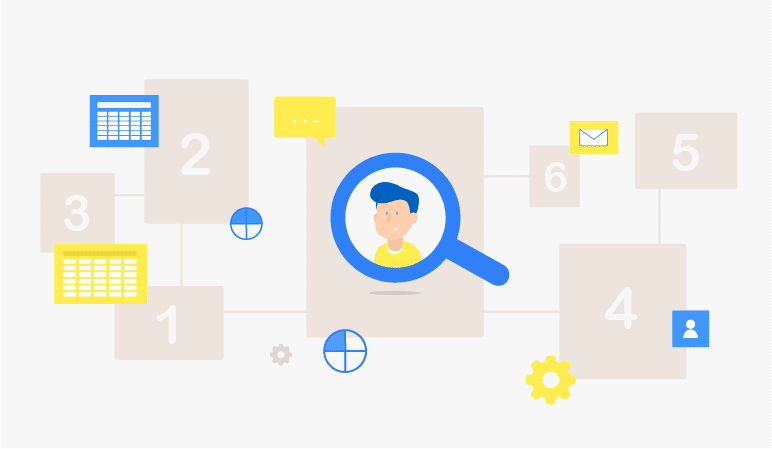6 steps to mapping staff competences
Discover the world of competence mapping in this article, where we explore its significance, advantages, and actionable strategies. Find out more to harness the full potential of your team.

Your staff’s competences are one of the cornerstones of your organization. Nowadays, especially in such a dynamic labor market, a person’s competences are perhaps more important than his or her level or area of education.
Mapping competences helps you quickly identify the skills and knowledge missing or present within your organization. What’s more, they’re often an indication of a person’s ambitions.
But how can you manage competences more effectively? What tools and techniques are available for mapping competences? And how should you best go about tackling this? We’ll be answering these questions for you one by one.
What are competences?Copied
Before we dive into the ‘how to’ of mapping competences, let’s first take a look at what a competence is exactly.
competence – a combination of knowledge, skills, attitudes, and/or personal traits demonstrated in a person’s behavior that allows them to achieve certain objectives in a work-related setting
A competence is effectively the sum of the following components:
- knowledge: information and experience
- skills: primarily, highly developed physical and/or mental abilities and coordination required to perform a certain task
- attitudes/personal traits: a person’s values in terms of how they define them as an individual and how they relate to and interact with their surroundings
Hence, a competence is broader than a skill. We’ve examined the differences between skills and competences in another of our articles.

Why map competences?Copied
Competence mapping has numerous benefits for both an organization’s management and the organization as a whole. Let’s take a closer look at the benefits of creating competence profiles.
1. The building blocks of competence management
A clear picture of which competences your staff already have, or still need to acquire, forms the basis for a solid competence plan.
More commonly known as a Personal Development Plan (PDP), a PDP provides insight into your or a staff member’s current competences, as well as an action plan for acquiring and mastering new skills or honing existing skills.
A PDP focuses primarily on the following points:
- What do you want to achieve in a professional capacity?
- What are your personal objectives and ambitions?
- Do you already have the right competences to achieve your ambitions and perform as effectively as possible? And, if not, which do you need to pay extra attention to?
A clear picture of existing and new competences within your organization is the main prerequisite for creating a solid competence plan.
2. Personalized training
Competence mapping allows managers to provide their staff personalized training.
Once you know which competences are well developed, or underdeveloped, it’s possible to identify what sort of coaching, supervision, and/or training meets their specific needs, requirements, and personal preferences.
Without this information, it remains guesswork – not exactly an effective approach!
3. Hard competences vs. soft skills
Besides specific hard skills, soft skills are also extremely important assets, especially in today’s job market.
For example, it goes without saying that a trainer or coach should have deep subject matter-related knowledge and expertise. But people, didactic, and communications skills are equally as important when fulfilling this role. Not only do copywriters need to be able to write well, but they also need to know how to reach people with their writing. Being able to market yourself is a trait that is then just as important for reach or conversion purposes as the actual ability to write.
Mapping competences makes it easier for managers to separate hard skills from soft skills. This can often lead to useful insights because soft skills are trickier to quantify than hard competences (qualifications, years’ experience, certification, etc.). Identifying and nurturing soft skills requires an insight into a person’s psyche and motivations.

6 steps to mapping competencesCopied
But how should go about creating competence profiles? What’s involved and what should you bear in mind to get the most out of competence mapping? We’ll be answering these questions in the following action plan.
1. List and select competences
The first step to creating a PDP involves creating a list of relevant competences. This also entails that you select the most important – from your organization’s perspective – required to perform a role or carry out a task.
Use a competence list and corresponding descriptions when making your selection.
2. Determine relevant behavioral indicators
Once you’ve identified the key competences, it’s important to assign behavioral indicators for each one.
But which indicators should you assign to each of the competences you’ve selected? Behavioral indicators are simply descriptions of observable traits that are evidence of competency.
For example, somebody who communicates effectively should be able to maintain good business relations both inside and outside the company, select and use relevant data, and formulate and present ideas and other information. It’s vital to define behavioral indicators as clearly and concisely as possible so that it’s actually possible to quantify them in practice.
3. Speak to staff
Once you’ve prepared the above, it’s time to talk to staff about acquiring and mastering new competences.
This can take one of several forms depending on the competence, the staff member, and the organization in question:
- structured interview – focuses primarily on set topics. This type of interaction involves working through a set of questions one by one and doesn’t really constitute a spontaneous discussion. Structured interviews are generally highly reliable and applicable.
- unstructured interview – focuses primarily on dealing more spontaneously with less clearly defined issues. The advantage of this type of discussion is its more spontaneous and open character, but this also makes it less reliable and applicable than a structured interview.
- behavioral interview – focuses primarily on past examples, using the STARRT technique (Situation/Task/Action/Result/Reflection/Transfer).
4. Assess current competence levels
Once you know which competences and behavioral indicators are important to your organization and who has which competences, and who doesn’t, the next step involves assessing current levels.
Several resources are available to help you with this part of competence mapping.
Assessment centers
Assessment centers specialize in evaluating competences. They’re often used for recruitment and selection purposes, or advising employees who are looking to switch jobs.
Assessments often involve role-play, personality surveys, or behavioral observation. It’s critical that you use the right form of assessment for each clearly defined competence profile.
The benefit of assessment centers is that they can observe behaviors in a highly specific context, which is more difficult when using other evaluation methods.
Development centers
Development centers focus on helping staff acquire and master new competences. They examine drive and motivation – what’s important to someone, how he or she hopes to grow and learn, and what support he or she needs to achieve this.
Development centers use a variety of techniques, for example, interviews, case studies, and skills tests. They also establish a dialog about professional development and play a role in broader professional development objectives.
Practical/written tests
Tests determine whether an employee has the required skill set required for a specific competence.
5. Evaluate and give feedback
Once you’ve gathered all the information about your staff’s skills, it’s time to evaluate and give feedback.
You can use tried-and-tested methods to do this, such as ‘situational competence profiling’. This gives 360° feedback and provides a detailed picture of the situation ‘as-is’. Does an employee exhibit a specific competence? Does he or she only demonstrate this in certain situations? Based on this information, mapping and managing competences becomes a lot easier.
Feedback could also be given during a regular performance review. Managers and staff enter into a dialog about how staff have performed and which competences need to be acquired, mastered, or honed. This also forms the basis for giving proper support with staff members’ career development plans.
Read more about giving feedback in another of our articles.
6. Predict future competences
By following the previous five steps, you now know which competences and behavioral indicators are critical to your organization. What’s more, you also know which competences are present or missing.
Fine for now! But what about tomorrow?
An important part of competence mapping involves looking to the future. Technology is advancing so rapidly that jobs, tasks, and competences, which are relevant today, may be less relevant tomorrow.
Try to take account of competences that will be required for your organization’s future success. By thinking about these issues now, your organization will be better equipped to stay ahead of the competition in the years ahead.

ClarifyCopied
Luckily, creating greater clarity isn’t a complex or time-consuming exercise these days. It’s 2019, after all! For years now, organizations have been creating skills matrices in spreadsheets, such as MS Excel. Although spreadsheets are certainly useful for mapping competences, they’re not necessarily all that clear or concise. Spreadsheets soon become highly complex, unworkable in terms of version management, and extremely prone to error – in other words, pitfalls at every turn.
AG5’s software solves these problems and automates many of the tasks that you have to perform manually when using spreadsheets. It provides clarity about your staff’s current skills, competences, and qualifications, allowing you to:
- enter proficiency updates and training results directly from the work floor
- put together project teams based specifically on the expertise and experience required for the task at hand
- set up notifications for individual staff members, groups, or certification about to lapse or expire
- identify the most qualified replacements for staff members off sick or away on vacation
- replicate organizational structures and the relationships between staff members and qualifications
If you’re looking for the right tools to provide greater clarity about your staff’s skills and competences, then please get in touch with us or schedule a personal demo and dive into the world of AG5!

